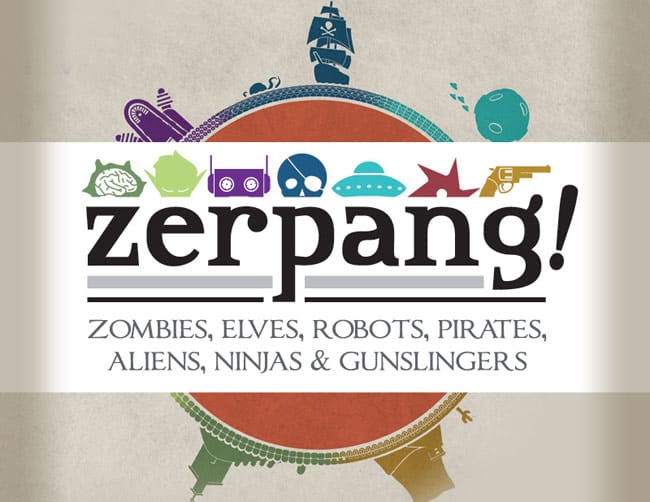
It’s not easy standing out as a mash-up game. Mark and I have been testing and demoing our flagship game Zerpang! since 2006. Back then, we were Catan-casual gamers and had no idea the “mash-up” theme would be a thing, but now there’s a small tangle of them in the market.

Zerpang! (which stands for Zombies, Elves, Robots, Pirates, Aliens, Ninjas and Gunslingers) started as a battle between ninjas and pirates, and quickly ballooned out to an exploration of other geek culture favorites. And now Brains, Grains and Trains, our half-joke “car ride idea“, is actually shaping up into a pretty solid game. What makes us so fascinated by the mash-up? And what can we expect as we bring both of these games to a finished state?
THE MASH-UP THEME AND TOYBOX APPEAL
While adult gamers have no qualms about spending the day immersed in fantasy and sci-fi games, pitting aliens versus zombies versus ninjas is more in line with what a kid does with a box full of random toys. It’s a little more structured than Lego bricks, which is a pure sandbox experience. There’s a definite appeal in subverting the typical narratives of your favorite characters and recontextualizing them. Go back to the time when your Ninja Turtles and Barbies all ran around on the floor Toy-Story-style and had adventures together. I call this toybox appeal.
And if you think about it, segmented games that are just about alien civilizations or just about knights battling dragons seem like an acquired taste. Toybox appeal games are familiar and refreshing when you’ve been surrounded by more rigid barriers between themes, and we shouldn’t be afraid to embrace them.
Deck builder mechanics are particularly suited to randomized mixing of elements to see what cool combos you can concoct. Choosing and shuffling up your cards in Smash-Up or Legendary mirrors the toybox appeal of dumping all your action figures together, and strike a chord because of that.
Lighter games also may choose to bank on theme alone: many casual gamers pick up something that just sounds awesome, regardless of whether or not it has replay value. In this case, they may keep the rules simple so the game can be driven by personal narrative as much as (or more than) mechanics.
AN EXERCISE IN ASYMMETRY
But if you think that just because a game has child-like appeal on the surface means there’s not much under the hood, you’re wrong. Reflecting the strengths of the faction is often a very careful balance in asymmetric mechanics, especially when all players have different options. And deckbuilders rely on the luck of the draw a lot, which can make for very frustrating impossible-to-win experiences if you’re not fortunate.
That’s something we wanted to challenge in our mash-up games: can we incorporate strong strategic decision making in a mash-up theme?
ZERPANG!

One of the reasons Zerpang! took so long to develop is because a lot of care, thought, and playtesting has to be put into making player roles and victory strategies different enough to reflect the essence of the geek culture favorites, yet fair enough so that anyone has a shot at winning.
- Pirates use card-based attacks and abilities. They’re good at collecting lots of loot (cards), barreling head-on into combat, and messing up other players.
- Ninjas also use card-based abilities, but are much more about moving quickly and sneaking in out of nowhere.
- Zombies are trying to spread infection rings by fighting other players. They have a “relentless” playstyle in that they can respawn from any place they infect.
- Aliens are trying to win in battle and abduct other players for study, and get bonuses when they abduct or release players.
- Robots are trying to upload to the cloud mind, and can share movement with other robots through their software.
- Gunslingers think they’re playing rummy, and can only play cards in pairs, three-of-a-kind, or straights, which give them multipliers to take down their opponents in one all-or-nothing shot.
- And Elves win if the game lasts too long, because everyone dies of old age. (the traditional elves are kind of a joke race since they aren’t actually allowed to do anything, but Kickstarter plans for a playable elf race are in the works)
While there’s some luck of the draw, the game opens a lot of possibilities while still staying true to the theme of each class. Your shot at winning is much more strongly linked to skill at defending your territory and strategically engaging your opponents, rather than luck.
BRAINS, GRAINS AND TRAINS

In Brains Grains and Trains, everyone has the same options, so the theme is not so much identifying with a character or role, but rather meta-commentary on the types of games in the market. Everyone starts with the same hand of cards and strategically activates them one at a time, similar to Concordia or Lewis and Clark. Your cards include abilities to:
- Keep the pesky zombie hoards at bay for points so they don’t block up delivery routes and worker locations.
- Collect and trade crops and tools from your workers, which can be delivered to locations for points.
- Expand your railway network to collect points when other players travel along them.
You also collect special cards when you make deliveries or get displaced from the board to enhance your abilities and multiply your points at the end of the game.
Again, our goal is to make every path to victory balanced, viable, and fun, while still keeping its toybox appeal of what all these common game themes would be like if a kid dumped them all together.
While plans for Brains Grains and Trains are still undecided, we hope to be bring Zerpang! to Kickstarter this year. And while it might be a little hard to tell our games apart just from the title, we hope that the attention to detail and balance we bring to our games will not go unnoticed in the sea of zombies, fairies, werewolves, vampires, dinosaurs, wizards, pirates and centaurs.
VIVA LA MASH-UP!








